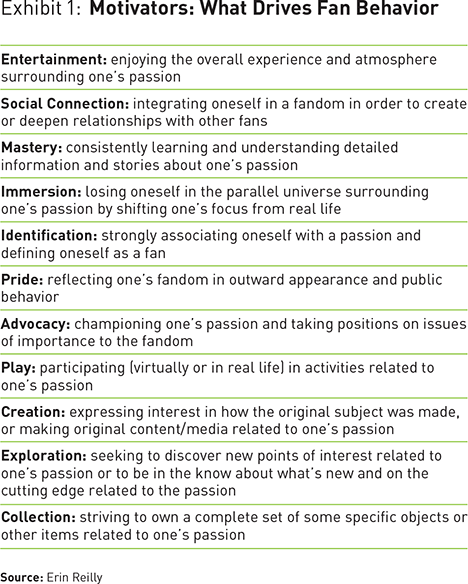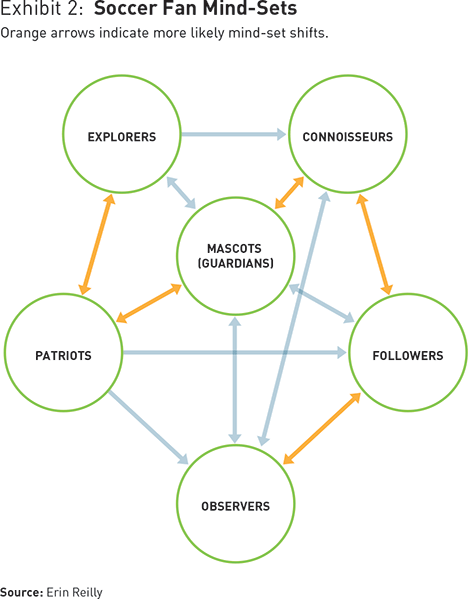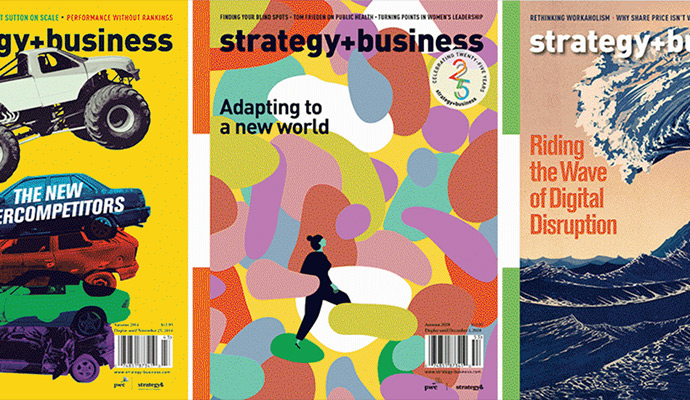Fan Favorites
In order to build engagement and loyalty in a climate of intense competition and distraction, media companies have to understand their customers, viewers, and readers as fans.
A version of this article appeared in the Autumn 2016 issue of strategy+business.
In 2014, I spent a lot of time around soccer fans. I regularly hung out at the sports bars frequented by Los Angeles’s official Real Madrid supporters club. My friends constantly shared with me, via email and social media, soccer-related websites, articles, and videos highlighting soccer fans and their love of the sport — and I clicked on them. I posted on soccer blogs, and rang up a bunch of credit card purchases in Brazil in July, during the World Cup. If my phone, the sites I visited, and the merchants I patronized had been collecting all the data associated with the places I went, the people I spoke to, and even the purchases I made, an analyst could easily have concluded that I was an ardent soccer fan (or, as people outside the U.S. would say, a football fan). But I’m not; at least, I wasn’t. At the time, I was studying sports fans as part of a research project with Havas Sports and Entertainment, to understand their passions and how they engage with brands — especially the brands that sponsor players, teams, and events in hopes of giving sports fans the experiences that they want. In doing so, I wound up becoming a case study in my own project.
My data trail marked me as a soccer fan, and continues to do so to this day. As I go about my business online, I am continually served automatically generated soccer-related recommendations and ads.
My experience is, of course, not unique. The widespread use of mobile devices has shifted the way we think about, understand, and participate in the world. Sometimes by permission (but often without our awareness), we continually funnel our locations, habits, desires, and selves into a pool of knowledge that every company wants to drink from in order to better understand and serve us. Each of us increasingly leaves behind trails of data that become crucial in shaping our digital identity.
Marketers, creatives, and nearly everyone else in the entertainment and media ecosystem are doing everything in their power to acquire and understand that data. They want to create relationships with their consumers, so that they remain loyal audience members, fans, and customers who really love their shows, their teams, and their brands.
In theory, new technological advances such as big data and machine learning, combined with more direct access to audience sentiment, behaviors, and preferences via social media and over-the-top delivery channels, give the entertainment and media industry unprecedented insight into what the audience actually wants. But as a professional in the television industry put it, “We’re drowning in data and starving for insights.” Just as my data trail didn’t trace an accurate picture of my true interest in soccer, no data set can quantify all that consumers are as humans. At USC’s Annenberg Innovation Lab, our research has led us to an approach that blends data collection with a deep understanding of the social and cultural context in which the data is created. This can be a powerful practice for helping researchers understand the behavior of fans — fans of sports, brands, celebrities, and shows.
A Model for Understanding Fans
Marketers and creatives often see audiences and customers as passive assemblies of listeners or spectators. But we believe it’s more useful to view them as active participants. The best analogy may be fans. Broadly characterized, fans have a continued connection with the property they are passionate about. Some are willing to declare their affinity through engagement, some have an eagerness to learn more about their passion, and some want to connect with others who share their interests. Fans are emotionally linked to the object of their passion, and experience their passion through their own subjective lenses. We all start out as audience members. But sometimes, when the combination of factors aligns in just the right way, we become engaged as fans.
For businesses, the key to building this engagement and solidifying the relationship is understanding the different types of fan motivations in different contexts, and learning how to turn the data gathered about them into actionable insights. Even if Jane Smith and her best friend are fans of the same show, the same team, or the same brand, they’re likely passionate for different reasons. For example, some viewers may watch the ABC melodrama Scandal because they’re fashionistas and can’t wait to see the newest wardrobe of star Kerry Washington; others may do so because they’re obsessed with politics and want to see how the Donald Trump–like character will behave. And those differences mean fans will respond in varied ways to different situations and content.
Although traditional demographics may give us basic information about who fans are and where they’re located, current methods of understanding and measuring engagement are missing the answers to two essential questions: (1) Why is a fan motivated? and (2) What triggers the fan’s behavior? Our Innovation Lab research group is developing a new model called Leveraging Engagement, which can be used as a framework when designing media strategy.
Fan Motivators
In his paper “Television 2.0: Reconceptualizing TV as an Engagement Medium” (2007), digital strategist Ivan Askwith offered an initial framework for thinking about viewer engagement. Here, we build on that insight by identifying certain motivators of fan engagement, which describe the various ways fans approach their passion and the goals that drive their behavior. The Leveraging Engagement model is an inexhaustible, shifting set of motivations — as we explore new genres of media, from e-sports to music sharing, new motivations emerge (see Exhibit 1). Here are a few examples of the motivators we’ve seen in different fandoms:
In sports, some fans engage through identification, strongly associating themselves with a passion and defining themselves as fans. Being a sports fan connects some fans to the place they call home; for others, their fandom is important because they believe the team they support says something about who they are. Anyone who has ever asked a resident of New York whether he or she is a Yankees or Mets fan can instantly appreciate the power of identification.
In unscripted entertainment where fans engage with a celebrity host, advocacy shines through as a motivator. Advocacy involves championing causes on behalf of one’s passion and taking positions on issues of importance to the fandom, as fans rally to support the celebrity’s causes or the positive impact they have on the community. For example, when comedian Jon Stewart held a March to Restore Sanity and/or Fear in Washington in 2010, more than 200,000 people showed up.
When comedian Jon Stewart held a March to Restore Sanity and/or Fear in Washington in 2010, more than 200,000 people showed up.
In music, the majority of music festival fans engage through social connection, or integrating oneself in a fandom in order to create or deepen relationships with other fans. For fans motivated this way, being around others who love the same music and enjoy singing along or dancing makes the experience.
In superhero story universes, the logic of mastery is manifested via a pronounced interest in learning and understanding detailed information and stories about one’s passion. Some fans might want to know everything there is to know about Batman’s history, whereas others might focus on certain details such as a specific period in time or a deep understanding of the relationship between Batman and Superman.
Fan Mind-Sets
Motivators act as lenses through which we can examine fans’ behaviors and desires to engage with a specific type of content, people, or brands. Very few, if any, fans exhibit only one of the motivators at any given time in their engagement. Instead, fans are usually engaging through mixtures of these motivators, and common mixtures are recognizable as recurring fan mind-sets.
For example, a common fan mind-set among Americans interested in music is the “Vocalist.” As the name implies, Vocalists frequently listen to music and sing along, most often in the car. Their mood drives their choice of song and genre. Vocalists typically look for new music to listen to and enjoy learning about music and musicians, and will still gladly purchase an album or other products artists might offer. However, they don’t go out of their way to attend concerts or festivals, even though they are more likely than most music fans to play and create music. The Vocalist mind-set is a combination of play, identification, and creation, but a Vocalist is not motivated by social connection or advocacy.
Fans operating with the “Mixologist” mind-set listen to music just as frequently as Vocalists; in contrast, however, their passion is tied closely to friends, family, and other fans who are eager to discuss and share their knowledge about music and musicians. It is the feeling of being connected to a community of fans that matters most, regardless of whether it’s in person at the Bonnaroo music festival or online via Phish fan sites. The Mixologist mind-set is a combination of social connection, advocacy, and exploration.
In our research, we’ve seen similar mind-sets emerge in both scripted and unscripted entertainment. There are fans of expansive story universes, such as Star Wars, who are just as obsessed as soccer “Connoisseurs,” eager to master everything there is to know about the history, characters, locations, and plot twists within that universe, and to share their knowledge with others. However, even if fans have the same motivators, their particular fan mind-sets (or the combination of motivators they’re exhibiting at any one moment) may lead them to express their passion via unique behaviors.
Understanding Triggers
Although most fans will hold just one of these fan mind-sets most of the time, they may shift to other mind-sets according to changes in their unique situational triggers. These triggers, which may take the form of tangible objects or discrete actions, can be based on a number of factors, including geographical and virtual location, level of knowledge, strength of social networks, and emotions. If media producers can understand the objects and actions that inspire certain fan mind-sets, they will be better able to create content and activities that can help these fans engage more deeply with a given team, story, or brand.
Let’s return for a moment to my experience as a soccer fan. One of the soccer fan mind-sets that emerged in our “Fans, Passions, Brands” study was that of the “Follower.” Followers are not likely to be aligned with any of the motivators we’ve identified except entertainment, and the most fleeting form of social connection, sparked largely by a desire to strengthen personal connections with friends and family. Followers enjoy watching, especially during close games or exciting finishes, but they are not deeply invested in being fans. The Follower mind-set is often held by the mothers and wives of more avid soccer fans. Followers could also be the fans who are turned off by some of the over-the-top elements of sports fandom, such as violence, excessive cheering, and poor sportsmanship. They typically don’t care much about understanding details and don’t possess strong opinions about the sport.
Even a year after my entry into soccer fandom, I identified myself as a Follower. But when my context changed, triggers altered my engagement and my identity. During my trip to Brazil for the World Cup, I socialized with devoted fans and attended large gatherings that shifted me from being a Follower to being a “Mascot.” Mascots are loud, high-energy, high-emotion, fun-loving fans. They get wild when matches get exciting. And they have a great time being fans. They love stories about the sport, but don’t pay much attention to statistics and tactics. Most importantly, Mascots are often partial to a specific team or nationality. When I went to Brazil, my favorite T-shirt featured Cristiano Ronaldo, the Portuguese striker with movie-star looks who plays for Real Madrid. But I watched the highly fraught game between Portugal and the United States — which ended in a last-second match-tying goal — in a crowded bar surrounded by screaming U.S. fans who were waving flags and chanting “U-S-A! U-S-A! U-S-A!” And when I became caught up in the moment, my behavior changed. Being united with fellow Americans, thoroughly entertained, I found that my new motivators were identification and pride. There was no way I was going to take off my USA sweatshirt to reveal the Ronaldo jersey underneath. I was right in there with everyone else, chanting loudly and feeling the pain of being robbed of our victory at the last second. In that moment, I was a Mascot of the U.S. team, and I still follow it today.
Enter on Your Own Terms
The challenge of working with the concept of fandom is the absence of a hierarchical ranking into which we can slot various fan groups. The entertainment and media industry widely believes that 80 percent of its revenue comes from the 20 percent of its audience who are frequently referred to as “superfans.” Some might not consider Followers to be true fans; in contrast, Connoisseurs could be classified as superfans. But this sort of taxonomy papers over the opportunities that each mind-set offers in an engagement strategy. And when we look at fans through the lens of our two core questions of motivations and triggers, we discover multiple points of entry into a fan community, with multiple versions of meaningful engagement.
The model displayed in Exhibit 2 offers insight into the pathways of potential mind-set shifts for soccer fans. As shown by one of the orange bidirectional arrows, “Patriots” (dutiful fans of their favorite team often connecting home and family to their passion) can transition into “Explorers” when they start to get excited about playing actual soccer, fantasy soccer, or soccer-related games.
Now, take a look at one of the blue bidirectional arrows. “Observers” don’t usually become Mascots without “leveling up” socially into the Follower mind-set first, but they can when the party atmosphere is most intense (at big international tournaments, for example). Moving in the other direction, most Mascots have too much single-team focus (rooted in identification and advocacy) to step back into a role as an Observer, but their loyalty isn’t as strong as that of Patriots, so they just might make that move if their team is doing badly for a long stretch of time.
When we move away from using terminology such as segmentation or using profiles that rigidly relegate fans to a specific group, and instead turn toward terms such as motivators, mind-sets, and situational triggers, we have a framework that encourages agility, evolution, and relevance to each person. We recognize the importance and complexity of each fan (and each potential customer), no matter how he or she chooses to engage.
Understanding Data
As fans exercise greater autonomy with respect to their media choices, industry leaders are seeking new, more refined ways to engage the majority of the audience, all the way down to niche communities. And the data is certainly there to assist in these efforts. The Internet and communications technology can help keep track of what fans are willing to purchase. Sentiment analysis has proven to be a useful tool in gaining the pulse of a specific time or situation, but cognitive analytics will help you use data to understand motivations and triggers in a way that supports effective decision making. In our research, we identified four steps to help you better understand your fans.
1. Ask the right questions. Keep in mind exactly what question you want answered, and be ready to return often to that question and reflect on whether it’s still the right one. If you make the mistake of collecting too much information, then you’ll be in the same situation as so many others who are “drowning in data and starving for insights.”
2. Standardize data collection. Relevant data sets are often owned or managed by multiple teams within a company or even external partners. When we studied a celebrity-driven unscripted entertainment property, we examined data sets from sources such as the show’s website, the celebrity host’s website, Facebook, and survey data. The lack of standardization across these platforms made it difficult to identify relationships and find deeper connections.
3. Expand your horizons. Relying only on proprietary data isn’t using the power of the Internet — or the power of businesses similar to your own that are trying to reach the same audience. In both our music and entertainment studies, we distinguished between social media posts that were “authored by the brand” and those “not authored by the brand.” The majority of the “authored by the brand” and celebrity endorsement “conversations” happened on Twitter and Facebook. The content shared offered minimal conversation or discussion. The motivators fans mainly engaged through were a combination of entertainment (for example, celebrities posting images and text such as “On set. Behind the scenes. This set is amazing!”) and social connection (with celebrities again posting text and images such as “Circled back with some old friends”). And the conversations were not particularly rich. By contrast, most of the conversation surrounding the “not authored by the brand” category happened on sites such as Reddit and Tumblr, which offered posts of greater depth and nuance. For example, a post on Reddit shares a potential theory of the story unfolding on a television series and asks for thoughts and feedback from the community. As a result, motivators such as creation, advocacy, and mastery emerged more frequently.
4. Foster interdisciplinary teams and mixed methods. It’s important for a research/consumer insights team to consist of both qualitative and quantitative experts, working together to develop the right set of questions to answer. Volumetric analysis, which is most prevalent in analytics today, allows researchers to identify specific performance metrics, such as the amount of time spent viewing content, comments, shares, and likes. Sentiment analysis has been widely used to address the signal-to-noise ratio inherent in volumetric analysis and provide a quick way to assess the attitude of a conversation by identifying the text as positive, negative, or neutral. Advanced approaches to cognitive analytics using both natural language processing and image recognition can help provide insights into motivations, behaviors, and situational triggers for engaging with content, people, or brands. The more your team is well-rounded in its ability to harness and analyze data, the more likely it is to grasp the patterns that are not always immediately evident.
All this work is not easy. The overriding challenge is to introduce the human element into the study of mass behavior. We have to learn to view a stadium filled with 100,000 soccer fans, or an audience of 7 million television viewers, or a collection of 900,000 Twitter followers as a large group of individuals — each with his or her own motivations, cultural context, and way of relating to others. But the effort is worth it. Putting the human touch and time into developing models will grant us the ability to model data and thus find new insights on fans’ mind-sets, tastes, proclivities, and interests. Offering a nuanced view to fans will help you better understand and respect what a fan values and how you, in return, can value the fan.
Reprint No. 16314
Author profile:
- Erin Reilly is managing director and research fellow for the Annenberg Innovation Lab at USC’s Annenberg School for Communication and Journalism. She consults with private and public companies in the areas of audience engagement, creative strategy, and transmedia projects, and is a member of the Academy of Television Arts & Sciences.







